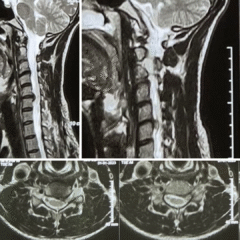Podcast: Play in new window
History :
28 -year-old gentleman came with complaints of severe neck pain since 3 months which had increased since last three days and left upper limb pain on and off since 4 months which was now very severe. He gave a history of lifting heavy weight 4-5 days ago at work following which his pain in hand had increased. Initially we gave him medications in the form of steroids but he did not improve at all, and was in agony so we decided to go Ahed with the surgery.
MRI :

The MRI report reveals abnormalities in the cervical spine, including a significant posterior disc protrusion and left paracentral herniation at the C5-C6 level, leading to compression of the thecal sac and indenting on the left nerve root. Additionally, mild posterior disc bulges are noted at the C3-C4 and C4-C5 levels, causing indentation on the thecal sac but to a lesser degree than the findings at C5-C6. These findings help in understanding the structural changes and potential sources of nerve compression in the cervical spine.
Posterior Disc Protrusion and Left Paracentral Herniation at C5-C6 Level:
A posterior disc protrusion refers to a bulging of the intervertebral disc towards the back of the spine.
A left paracentral herniation is an abnormal protrusion of the disc material to the left side near the center of the spine.
These findings are observed specifically at the C5-C6 level of the cervical spine.
The protrusion and herniation are causing compression of the thecal sac, which is a protective membrane surrounding the spinal cord, and indenting on the left nerve root.
Mild Posterior Disc Bulges at C3-C4 and C4-C5 Levels:
At the C3-C4 and C4-C5 levels of the cervical spine, there are mild posterior disc bulges.
These bulges are also causing indentation on the thecal sac, similar to the findings at the C5-C6 level.
However, it’s important to note that these bulges are described as mild, indicating they may not be causing significant compression or nerve impingement compared to the more pronounced protrusion and herniation at the C5-C6 level.
Operation :

On October 1, 2023, Dr. Sangram Rajale performed a transforaminal lumbar interbody fusion (TLIF) at the L5-S1 level of the spine on a patient under general anesthesia. TLIF is a surgical procedure that aims to stabilize the spine by removing a damaged disc and inserting implants, specifically using Jayon implants, to promote bone growth and fusion between vertebrae, thus addressing issues like disc herniation and instability.
Condition On Discharge :
The patient underwent C5-C6 anterior cervical discectomy and fusion (ACDF) surgery on April 1, 2023.
Following the procedure, the patient showed significant improvement in his condition.
Post-surgery, he was in a stable condition and was promptly shifted to the ward for recovery.
He was able to walk in the ward on the same day, demonstrating good initial mobility and functionality after surgery.
The recovery progressed smoothly, and he was discharged on the third day post-operation.
The rapid recovery highlighted both the effectiveness of the surgery and the patient’s resilience.
By the end of the first week after discharge, he had already resumed his work, reflecting his quick return to daily activities.
The patient experienced complete relief from pain, resulting in a significantly improved quality of life.
He expressed feeling very happy and satisfied with the outcome of the surgery.
